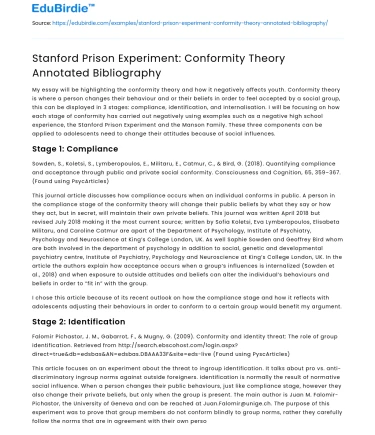My essay will be highlighting the conformity theory and how it negatively affects youth. Conformity theory is where a person changes their behaviour and or their beliefs in order to feel accepted by a social group, this can be displayed in 3 stages: compliance, identification, and internalisation. I will be focusing on how each stage of conformity has carried out negatively using examples such as a negative high school experience, the Stanford Prison Experiment and the Manson Family. These three components can be applied to adolescents need to change their attitudes because of social influences.
Stage 1: Compliance
Sowden, S., Koletsi, S., Lymberopoulos, E., Militaru, E., Catmur, C., & Bird, G. (2018). Quantifying compliance and acceptance through public and private social conformity. Consciousness and Cognition, 65, 359–367. (Found using PsycArticles)
Save your time!
We can take care of your essay
- Proper editing and formatting
- Free revision, title page, and bibliography
- Flexible prices and money-back guarantee
This journal article discusses how compliance occurs when an individual conforms in public. A person in the compliance stage of the conformity theory will change their public beliefs by what they say or how they act, but in secret, will maintain their own private beliefs. This journal was written April 2018 but revised July 2018 making it the most current source; written by Sofia Koletsi, Eva Lymberopoulos, Elisabeta Militaru, and Caroline Catmur are apart of the Department of Psychology, Institute of Psychiatry, Psychology and Neuroscience at King’s College London, UK. As well Sophie Sowden and Geoffrey Bird whom are both involved in the department of psychology in addition to social, genetic and developmental psychiatry centre, Institute of Psychiatry, Psychology and Neuroscience at King’s College London, UK. In the article the authors explain how acceptance occurs when a group’s influences is internalized (Sowden et al., 2018) and when exposure to outside attitudes and beliefs can alter the individual’s behaviours and beliefs in order to “fit in” with the group.
I chose this article because of its recent outlook on how the compliance stage and how it reflects with adolescents adjusting their behaviours in order to conform to a certain group would benefit my argument.
Stage 2: Identification
Falomir Pichastor, J. M., Gabarrot, F., & Mugny, G. (2009). Conformity and identity threat: The role of group identification. Retrieved from http://search.ebscohost.com/login.aspx?direct=true&db=edsbas&AN=edsbas.DBAAA33F&site=eds-live (Found using PyscArticles)
This article focuses on an experiment about the threat to ingroup identification. It talks about pro vs. anti- discriminatory ingroup norms against outside foreigners. Identification is normally the result of normative social influence. When a person changes their public behaviours, just like compliance stage, however they also change their private beliefs, but only when the group is present. The main author is Juan M. Falomir-Pichastor, the University of Geneva and can be reached at Juan.Falomir@unige.ch. The purpose of this experiment was to prove that group members do not conform blindly to group norms, rather they carefully follow the norms that are in agreement with their own personal motivations, beliefs and values. A better known example of the identification stage is The Stanford Prison Experiment, in 1971, the students took on their roles as abusive prison guards or as submissive prisoners in an experiment to understand the development of norms and the effects of roles, labels, and social expectations.
I chose this article because they had the same findings in their experiment as the Stanford Prison Experiment and provided an in depth view on the identification stage.
Stage 3: Internalisation
Altman, R. (2015). Sympathy for the Devil: Charles Mansons Exploitation of ... Retrieved October 18, 2019, from https://scholar.colorado.edu/cgi/viewcontent.cgi?article=2017&context=honr_theses. (Found using Google Search Engine)
This academic journal looks at the Mason family and how Charles Mason manipulate his followers to commit sinister acts by creating a “family” to fulfill his followers basic needs. Internalisation is the strongest form of conformity and is when an individual wants to be accepted so badly that they change their beliefs and adapt to an entirely different behavior. When an insecure and vulnerable person is trying to conform to a certain group they are likely to get taken advantage of and are easily taken in by low life personalities. Charles Masnon was a prime example of someone who would take advantage of vulnerable people. Manson was a cult leader in the 1960s’ whom is famous for preying on a vulnerable young people by becoming a crucial part of their identity and self esteem. He went on to create the “Manson Family”, a group of loyal followers who eventually committed murders of 7 people. Robin Altman, University of Colorado is the author of this academic paper and wrote the paper for his bachelor of arts in history with honours in april of 2015.
I chose to research and include the Manson Family in my theory of conformity paper because this cult showcased how conformity at its strongest form can function in such a negative way and in this case killing to satisfy the groups leader.






 Stuck on your essay?
Stuck on your essay?

